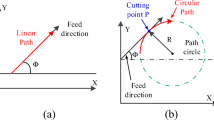Abstract
Ultra-precision machining is a class of feasible and efficient technology to generate high-precision optical surfaces. However, the machining tool mark is a significant fact that leads to unwanted diffraction, which will seriously affect the optical performance. In this paper, the relationship between optical performance and tool marks is systematically studied. The results show that the effect of tool marks depends on the ratio of tool feed f and tool nose radius R. Moreover, the effect of tool marks is more severe in the optical system with two mirrors because of superposition. It is proposed that a decreasing ratio of f to R and changing the angle of tool marks between two optical elements can assist to improve the optical performance of the system. Hence, this study provides theoretical guidance to reduce the impact of tool marks and improve the optical performance of the system.
















Similar content being viewed by others
References
S. Zhang, S. To, S. Wang, Z. Zhu, A review of surface roughness generation in ultra-precision machining. Int. J. Mach. Tool. Manuf. 91, 76 (2015)
X. Liu, X. Zhang, F. Fang, Z. Zeng, H. Gao, X. Hu, Influence of machining errors on form errors of microlens arrays in ultra-precision turning. Int. J. Mach. Tool. Manuf. 96, 80 (2015)
F. Chen, S. Yin, H. Huang, H. Ohmori, Y. Wang, Y. Fan, Y. Zhu, Profile error compensation in ultra-precision grinding of aspheric surfaces with on-machine measurement. Int. J. Mach. Tool. Manuf. 50, 480 (2010)
S. Wang, S. To, C.F. Cheung, An investigation into material-induced surface roughness in ultra-precision milling. Int. J. Mach. Tool. Manuf. 68, 607 (2013)
D. Li, B. Wang, Z. Qiao, X. Jiang, Ultraprecision machining of microlens arrays with integrated on-machine surface metrology. Opt. Express 27, 212 (2019)
S.A.U. Hasan, H. Youn, Y. Park, H. Lee, Imaging performance of an ultra-precision machining-based Fresnel lens in ophthalmic devices. Opt. Express 29, 32068 (2021)
J. Li, M. Huang, W. Wei, H. Yang, J. Yuan, P. Liu, Study on traceability and suppression method of medium-frequency error for ultra-precision machining optical crystals. Opt. Express 29, 22252 (2021)
Y. Li, S.M. Gracewski, P.D. Funkenbusch, J.L. Ruckman, Minimizing tool marks in deterministic microgrinding, in: Current Developments in Optical Design and Engineering VII, SPIE 80 (1998)
M. Pohl, R. Börret, Simulation of mid-spatials from the grinding process. J. Eur. Opt. Soc. Rapid Publ. 11, 16010 (2016)
T.K. Gaylord, M. Moharam, Analysis and applications of optical diffraction by gratings. Proc. IEEE 73, 894 (1985)
Z. Li, F. Fang, X. Zhang, X. Liu, H. Gao, Highly efficient machining of non-circular freeform optics using fast tool servo assisted ultra-precision turning. Opt. Express 25, 25243 (2017)
X. Zhang, Z. Li, G. Zhang, High performance ultra-precision turning of large-aspect-ratio rectangular freeform optics. CIRP Ann. 67, 543 (2018)
Z. Li, X. Liu, F. Fang, X. Zhang, Z. Zeng, L. Zhu, N. Yan, Integrated manufacture of a freeform off-axis multi-reflective imaging system without optical alignment. Opt. Express 26, 7625 (2018)
H. Zhang, X. Zhang, Z. Li, P. Wang, Z. Guo, Removing single-point diamond turning marks using form-preserving active fluid jet polishing. Precis. Eng. 76, 237–254 (2022)
A. Ghosh, N. Pandey, K.K. Pant, D. Mohan, Subaperture polishing of silicon asphere. J. Opt. 48, 266–271 (2019)
S. Chen, S. Li, H. Hu, G. Tie, C. Guan, Q. Li, Analysis of surface quality and processing optimization of magnetorheological polishing of KDP crystal. J. Opt. 44, 384–390 (2015)
Y. Xing, C. Li, Y. Liu, C. Yang, C. Xue, Fabrication of high-precision freeform surface on die steel by ultrasonic-assisted slow tool servo. Opt. Express 29, 3708–3723 (2021)
M. Kumar, H.N. Singh Yadav, A. Kumar, M. Das, An overview of magnetorheological polishing fluid applied in nano-finishing of components (2021). https://doi.org/10.1177/25165984211008173
A. Beaucamp, R. Freeman, R. Morton, K. Ponudurai, D. Walker, Removal of diamond-turning signatures on x-ray mandrels and metal optics by fluid-jet polishing. Adv. Opt. Mech. Technol. Telesc. Instrum. Int. Soc. Opt. Photonics 701835 (2008)
J. Guo, W. Feng, H.J.H. Jong, H. Suzuki, R. Kang, Finishing of rectangular microfeatures by localized vibration-assisted magnetic abrasive polishing method. J. Manuf. Process. 49, 204 (2020)
M. Cheng, C.F. Cheung, W.B. Lee, S. To, A study of factors affecting surface quality in ultra-precision raster milling. Key. Eng. Mater. Trans. Tech. Publ. 400 (2007)
L. Li, S.A. Collins, A.Y. Yi, Optical effects of surface finish by ultraprecision single point diamond machining. J. Manuf. Sci. E-T. Asme 132 (2010)
F.-Z. Fang, K.-T. Huang, H. Gong, Z.-J. Li, Study on the optical reflection characteristics of surface micro-morphology generated by ultra-precision diamond turning. Opt. Laser. Eng. 62, 46 (2014)
Z. Zhu, S. To, S. Zhang, Active control of residual tool marks for freeform optics functionalization by novel biaxial servo assisted fly cutting. Appl. Opt. 54, 7656 (2015)
J.M. Tamkin, W.J. Dallas, T.D. Milster, Theory of point-spread function artifacts due to structured mid-spatial frequency surface errors. Appl. Opt. 49, 4814 (2010)
J.M. Tamkin, T.D. Milster, W. Dallas, Theory of modulation transfer function artifacts due to mid-spatial-frequency errors and its application to optical tolerancing. Appl. Opt. 49, 4825 (2010)
F. Wyrowski, M. Kuhn, Introduction to field tracing. J. Mod. Opt. 58, 449 (2011)
J.A. Shultz, M.A. Davies, T.J. Suleski, Effects of MSF errors on performance of freeform optics: comparison of diamond turning and diamond milling. Freeform Optics. Optical Society of America FT4B. 3 (2015)
Acknowledgements
This research was funded by the National Key Research and Development Program of China (2017YFA0701200), Tianjin Science and Technology Program (19JCZDJC39100) and National Postdoctoral Program for Innovative Talents of China (BX20190230).
Author information
Authors and Affiliations
Corresponding author
Ethics declarations
Conflict of interest
The authors declare that they have no conflict of interest.
Additional information
Publisher's Note
Springer Nature remains neutral with regard to jurisdictional claims in published maps and institutional affiliations.
Rights and permissions
About this article
Cite this article
Yan, N., Liu, X., Li, Z. et al. Study on tool mark-induced performance degradation in optical system: simulation and application of field tracing. J Opt 52, 365–375 (2023). https://doi.org/10.1007/s12596-022-00914-z
Received:
Accepted:
Published:
Issue Date:
DOI: https://doi.org/10.1007/s12596-022-00914-z



